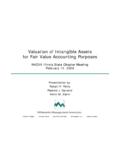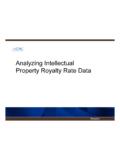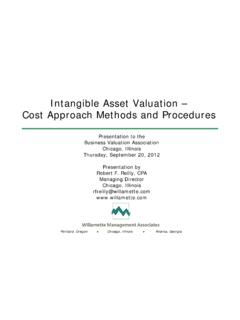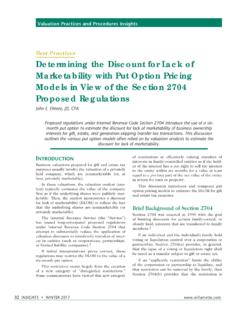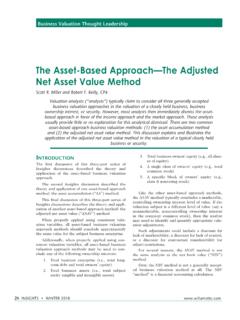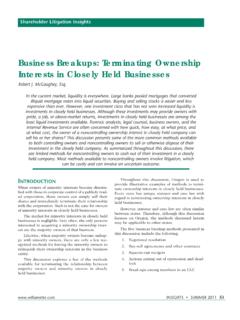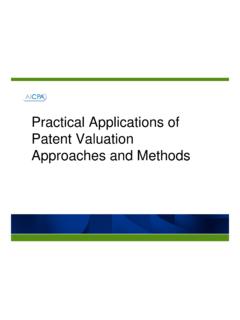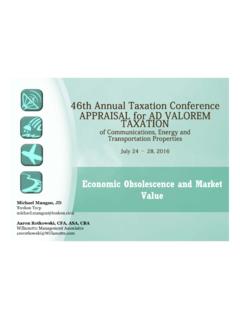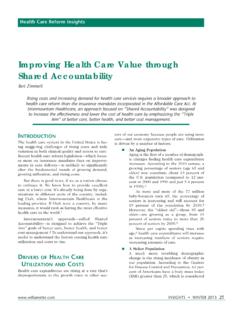Transcription of Goodwill Valuation Approaches, Methods, and Procedures
1 Financial Advisory Services Insights Goodwill Valuation approaches , methods , and Procedures Robert F. Reilly, CPA. Financial advisers are often asked to value Goodwill within a corporate transaction environment. These Goodwill valuations may be performed in the due diligence phase of the corporate transaction for transaction pricing and structuring purposes. These Goodwill valuations may be performed in the consummation phase of the corporate transaction as part of the preparation of a transaction fairness opinion or solvency opinion. And, these Goodwill valuations may be performed within the controversy phase of the corporate transaction to defend against dissenting shareholder appraisal rights claims or claims that the transaction resulted in a fraudulent transfer. For some transaction- related purposes, financial advisers may value Goodwill as a residual amount ( , the residual of a total business or professional practice value minus the value of all identifiable tangible assets and intangible assets ).
2 For other transaction- related purposes, financial advisers may value Goodwill as an individual, income-producing intangible asset . This discussion summarizes the generally accepted Goodwill Valuation approaches , methods , and Procedures . And, this discussion presents an illustrative example of a Goodwill Valuation analysis. Introduction defend against dissenting shareholder appraisal rights claims or claims that the corporate transac- There are different types of Goodwill , including (1) tion involved a fraudulent transfer business or institutional Goodwill and (2) personal This discussion summarizes the generally accept- or professional Goodwill . Financial advisers are often ed approaches and methods related to the Valuation asked to value these different types of Goodwill for of Goodwill . This discussion focuses on business transaction, taxation, financial accounting, litiga- enterprise (or institutional) Goodwill . However, this tion, and other purposes. This discussion describes discussion also considers personal (or individual).
3 The various components of Goodwill and the various Goodwill . reasons why independent financial advisers may be asked to value Goodwill . This discussion starts with a definition of good- will. Since there is no single definition of Goodwill Financial advisers are often asked to value good- that is applicable to all purposes, this discussion will within a corporate transaction environment. considers alternative definitions. This discussion These Goodwill valuations may be performed in the describes the types and attributes of Goodwill . And, due diligence phase of the corporate transaction this discussion considers the many reasons why for transaction pricing and structuring purposes. financial advisers are asked to value Goodwill . These Goodwill valuations may be performed in the consummation phase of the corporate transac- Finally, this discussion mentions many of the tion as part of the preparation of a transaction common internal and external data sources related fairness opinion or solvency opinion.
4 And, these to the Goodwill Valuation . These data sources pri- Goodwill valuations may be performed within the marily include sources of transactional data regard- controversy phase of the corporate transaction to ing the sale of Goodwill within the context of a busi- ness acquisition. 10 INSIGHTS SPRING 2015 Some financial advisers believe that only income concern) premise of value rather than on a value approach methods are applicable to value Goodwill . in exchange (or piecemeal disposition) premise of However, this discussion describes cost approach, value. market approach, and income approach Valuation Some going-concern value may attach to the methods . This discussion concludes with an illustra- business entity's specifically identified identifiable tive Goodwill Valuation example. intangible assets . For example, an entity's patent, copyright, or trademark value is typically greater when that intangible asset is appraised on a value in Goodwill Components continued use (or going-concern) premise of value There are many interpretations of Goodwill .
5 These rather than on a value in exchange (or piecemeal interpretations are generally grouped into two cat- disposition) premise of value. egories: residual interpretations and income inter- The second Goodwill component is the exis- pretations. While income interpretations may be tence of excess income (however measured). This more common, financial advisers should be familiar component is described later in this discussion. with both categories of interpretations. Both inter- For a business entity, excess income is income pretations agree on the components of (or the fac- generated by the entity that is greater than the tors that create) Goodwill and the types of Goodwill amount needed to provide a fair rate of return on (or situations in which Goodwill arises). all of the entity's tangible assets and identifiable There are three principal components of good- intangible assets . will. Financial advisers consider these three compo- This excess income component relates to the nents as either (1) the factors that create Goodwill concept of Goodwill as that portion of business or (2) the reasons why Goodwill exists in certain enterprise value that cannot be specifically assigned circumstances.
6 The first and third components pri- to the entity's tangible assets or identifiable intan- marily relate to business Goodwill . And, the second gible assets. For an individual ( , professional component relates to both business Goodwill and practitioner, athlete, celebrity), excess income is personal Goodwill . the income generated by the individual that is The first Goodwill component is the existence of greater than the amount that would be expected to operating business assets that are in place and ready be accrued by a comparably skilled individual work- to use. This component is sometimes referred to as ing in comparable circumstances. the going-concern element of Goodwill . The fact that The third Goodwill component is the expectation all of the elements of a business enterprise are phys- of future events that are not directly related to the ically and functionally assembled creates intangible entity's current operations. Goodwill may be created value. These business enterprise elements include by the expectations of future capital expenditures, capital ( , equipment), labor ( , employees), future mergers and acquisitions, future to-be-devel- and coordination ( , management).
7 Oped products or services, and future customers or Some financial advisers identify and measure clients. This future expectations component relates this going-concern value as a separate intangible to the concept of Goodwill as the current value of asset of a business . This separate identification future assets (both tangible and intangible) that do may be appropriate for certain taxation or forensic not yet exist on the analysis date. analysis purposes. Investors assign a Goodwill value to a business Other financial advisers measure going-concern entity if they expect that the net present value of value as one component of the entity's business the income associated with future events is positive. Goodwill . This aggregate identification is appropri- The positive net present value of the expected future ate for purposes of Financial Accounting Standards income associated with assets that are already in Board (FASB) Accounting Standards Codification existence (for example, capital assets, product lines, (ASC) Topic 805, business Combinations, fair value and customers) is appropriately assigned to those accounting for business combinations.
8 Respective tangible assets and intangible assets . Either identification procedure may be appropri- ate depending on the purpose and objective of the Goodwill analysis. The Residual Interpretation of This going-concern value may enhance the value Goodwill of the business entity's individual operating assets. Under generally accepted accounting principles, the For example, a business entity's equipment value is Goodwill that an entity develops in the normal course typically greater when the equipment is appraised of business is rarely recorded on the entity's financial based on a value in continued use (or going- statements. And, the accounting recognition for INSIGHTS SPRING 2015 11. internally created Goodwill is different than the intangible assets . This allocation of the entity's accounting recognition for purchased Goodwill . income is typically based on a fair rate of return Internally created Goodwill is rarely recorded on on the asset category multiplied by the value of the the entity's balance sheet.)
9 In contrast, purchased asset category. Goodwill is recorded on the acquiror's balance sheet Third, the financial adviser typically quantifies as soon as the purchase transaction is completed. the portion of the entity's income that cannot be Under FASB ASC topic 805 acquisition accounting, associated with any other tangible or intangible the fair value (calculated as a residual from total asset . That residual income is often called excess purchase consideration) of purchased Goodwill is income (or excess earnings). This excess income is recorded as an intangible asset on the acquiror's then assigned to Goodwill . balance sheet. Fourth, Goodwill value is typically quantified Accountants often use a fairly broad definition as this amount of excess income capitalized as an of Goodwill . This broad interpretation of Goodwill is annuity in perpetuity. The excess income is capital- the residual value that is calculated by subtracting ized by a risk-adjusted and growth-adjusted direct the fair value of all the acquired tangible and iden- capitalization rate.
10 The result of this direct capital- tifiable intangible assets from the acquired entity's ization procedure indicates the Goodwill value. total purchase price. Sometimes this Goodwill definition collectively quantifies all of the intangible value of the acquired Goodwill Types company. This is the case when all of the identifi- There are three general Goodwill types. These three able intangible assets are not adequately identified Goodwill types may affect the identification and and valued. ownership of the Goodwill . But, the distinction of This collective Goodwill Valuation may occur these three types of Goodwill should not affect the when the fair values of the individual identifiable Valuation results. intangible assets are immaterial compared to the The first Goodwill type is institutional Goodwill . total business purchase price. In this circumstance, This is the Goodwill that relates to an industrial this residual definition of Goodwill may capture or commercial business enterprise.
